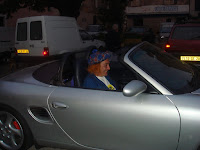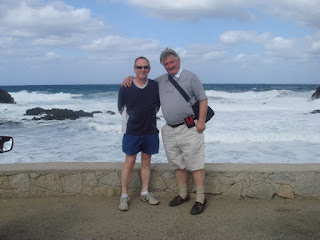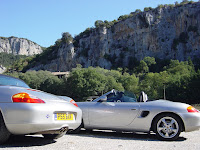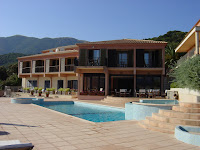
Wednesday, 10 October 2007
Corsica - Porsche Club trip
.
We gathered at Moulin from our diverse Channel crossings to enjoy dinner and a comfortable overnight stay before heading south.
Our tour agent, Travel Destinations, suggested a route avoiding motorways, which offered us a wide choice of charming rural towns to explore and enjoy lunch.
.
Our group stopped in Vichy, known to me only for its famous water and as the seat of government
 during world war two.
during world war two..
I am repeatedly fascinated by the French practice of taking a long lunch, and Vichy did not disappoint: deserted at one, save for the bars and restaurants, and reborn at three.
.
After a helpful gendarme had shown us where to park, we too enjoyed a lazy bistro lunch and a stroll around this elegant town before heading off for our next stop at Aubenas.
Millions of years ago the River Ardèche cut an immense canyon through the limestone rocks, and created a magnificent natural arch over two hundred feet high as a triumphal entrance.

.
.
Our French hosts also clearly enjoyed the parade of sportscars, which often proved of greater interest to them than the spectacular scenery!

 .
.That evening we reassembled at Marseille docks to board the overnight ferry to Ajaccio, involving a lengthy bureaucracy so beloved of the French, which eventually yielded the necessary embarkation documents and cabin allocations.
.
.
However, once aboard the spacious cabins, excellent cuisine, ample bar and flat calm sea combined to give us all an enjoyable crossing.
.
The Hotel Castel d’Orcino, on the west coast of Corsica near Calcatoggio, was our base for the next week. It is situated on a rocky shore overlooking the Golfe de Sagone, with breathtaking view across the bay. Our party had almost exclusive use of this family run hotel, and by the end of our stay we had been made to feel part of their family.
.
 name Corsica ‘Tailgate Island’.
name Corsica ‘Tailgate Island’..

Mountains dominate the landscape, the highest approaching 9,000 feet with twenty other peaks over 6,500 feet, so most journeys involve a col or a detour. Corsica is a région of France and governed as such, but the Corsicans are fiercely independent and keen to promote their own language and culture. Dual language signs frequently have the French version obliterated, and graffiti symbols of the independence movement are widespread.
.

Napoleon is the capital Ajaccio’s most famous son, but the tiny museum squeezed into a grubby side street is a clear indication of the indifference of the locals. However, presumably on the basis that my enemy’s enemy is my friend, they seem to like us Brits; we enjoyed a great welcome everywhere!
.
With a whole week to explore and a host of suggested routes to try, our party set off in small groups to the four corners of the island.
 .
.
.
Alan, Graham & I set off on our first trip. This most impressive tour took us on a circular route north along the west coast to Piana and Porto, then inland to the enchanting village of Evisa, completing the loop home via Vico and Sagone.
.
This took us along rugged coastline with unspoilt coves round every corner to the coastal fishing village of Piana and Porto and then up an amazingly twisty road to the mountain village of Evisa.
We enjoyed a wonderful lunch at a little restaurant in the village where we joined a few others from our group for a long lunch break and the usual gourmet food.
..

.
It was really nice to be engaged in conversation by the locals, who were interested in our long journey from the UK, our cars, and much more tolerant of our very poor French than their mainland cousins.
It is exhilarating to drive along the coast road, no more than a narrow man-made shelf on the side of the mountain, stop in a one car lay-by and gaze across the rocky sculptures at the azure blue sea. In the main we were blessed with good weather, usually cloudless sunshine in the mornings with gathering clouds later in the day, and the top down all the time, naturally!
 .
.On Saturday we abandoned our cars and took a Promenade en Mer to Scandola, an amazing UNESCO world heritage site of rocky coastline in the north west accessible only by boat.

 On our final day our small group ventured to Filitosa, a prehistoric site, south of Ajaccio. It was an adrenaline run along narrow roads that are used by World Rally Corsica but rewarded us with some fantastic views, and predictably provided us with another superb very late lunch at a tiny bistro in a little resort called Porto Pollo.
On our final day our small group ventured to Filitosa, a prehistoric site, south of Ajaccio. It was an adrenaline run along narrow roads that are used by World Rally Corsica but rewarded us with some fantastic views, and predictably provided us with another superb very late lunch at a tiny bistro in a little resort called Porto Pollo. from the pig, the eggs had golden yokes and the chips were freshly made. I must say I don’t succumb to this indulgence and had a salad instead.
from the pig, the eggs had golden yokes and the chips were freshly made. I must say I don’t succumb to this indulgence and had a salad instead. .

Filitosa is a megalithic site. The period of occupation spans from the end of the Neolithic era and the beginning of the Bronze Age, until around the Roman times in Corsica. The site was discovered in 1946 by the owner of the land, Charles-Antoine Cesari. Systematic excavations started in 1954. Finds of arrow heads and pottery date earliest inhabitation to 3300 BC. Around 1500 BC, 2-3 metre menhirs were erected. They have been carved with representations of human faces, armour and weapons. It is thought the menhirs may have been erected to ward off an invasion of a group of people called the Torréens (Torreans). Find out more by clicking HERE.
.
.
We sailed from Ajaccio on Wednesday evening under a beautiful sunset with many pleasant memories of a delightful island and its hospitable people, well worth the long drive, especially in a Porsche!
.
.
The return sailing to Marseille in a force eight gale was less so, but a mixture of Kwells (thanks Patricia!) and sleep enabled most of us to survive the crossing unscathed.
A detour to see the amazing Millau bridge on the way back north to Moulin was made by quite a few of us.
There was a request made for Alan & I to have our photo taken with a Dutchman and 

 completed our trip on a high note. Hic, hic!
completed our trip on a high note. Hic, hic!
Our sincere thanks to Pearl and Phil Sharland from the Kent region for organising the trip. I have already booked to go on next year’s trip to the Italian Lakes!
Tuesday, 9 October 2007
New Friends


 While there we "entertained" the local people by wearing our "Hey Jimmy" hats that Alan had brought with him for the road trip for a bit of a laugh.
While there we "entertained" the local people by wearing our "Hey Jimmy" hats that Alan had brought with him for the road trip for a bit of a laugh. 



More Photos of our tour


View from above Calcatoggio

 At the Marseille ferry ready to board.
At the Marseille ferry ready to board.The entry to our village

the three of us!
Doug & Marlies on the Millau Bridge

On the Girolata Cruise with Alan


A pride of Porsche rears
























